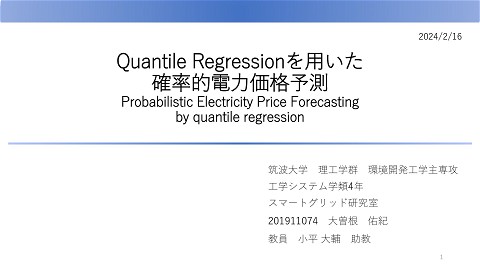2019_Optimal Scheduling of Energy Storage System for Peak Reduction Using a Prediction Interval
351 Views
March 31, 22
スライド概要
Control of Smart Grid and Renewable Energy Systems - CSGRES 2019
小平大輔 - 筑波大学エネルギー・環境系助教。現在の研究テーマは、電気自動車の充電スケジューリング、エネルギー取引のためのブロックチェーン、太陽光発電とエネルギー需要の予測など。スライドの内容についてはお気軽にご相談ください:kodaira.daisuke.gf[at]u.tsukuba.ac.jp
関連スライド
各ページのテキスト
1 Optimal Scheduling of Energy Storage System for Peak Reduction Using a Prediction Interval Daisuke Kodaira e-mail: [email protected]
2 Peak shaving using Energy Storage System (ESS) Demand [MW] Objective: • Peak shaving on distribution network (22.9kV) by ESSs [hour] 0 6 12 18 24
3 System configuration • Two Energy Storage Systems (batteries) are installed in the field • The ESSs are controlled by remote. The schedule is determined by the network operator 24 hours ahead Substation to ESS1: 5.8 km ESS1 to ESS2: 9.5 km Load 22.9 kV ESS2 to end of line: 7.4 km PV ESS1 PCS: 0.75 MW Battery: 1.5 MWh Network operator controls ESSs by remote ESS2 PCS: 1 MW Battery: 2 MWh
4
5 The steps of peak shaving Evaluation Load Prediction • Load Prediction - How much is the peak tomorrow? - When will the peak comes tomorrow? • ESS scheduling - What is the best schedule of ESSs? ESS Scheduling • Evaluation - How much we shaved the peak?
6 Load Prediction - problem The prediction is not always reliable…. Load on feeder MW Observed Load “Prediction tells us we don’t need to operate ESS for peak” Line capacity 10 Predicted Load 6 0 1 2 3 ・・・・ 23 hour Now ESS cannot reduce the peak appropriately in case the prediction has huge error
7 Load Prediction - solution The concept of probability is necessary to evaluate the risk Prediction Interval (PI) Line capacity “Prediction tells us the load falls into gray zone with 95% probability” Prediction with PI is proposed by many existing studies ➢ How can we utilize the PI for ESS control?
8 From Load Prediction to ESS operation Probability Load [MW] 0 5 3 8 ・・・・ 4 Probability Load [MW] 5 8 10 11 14 ・・・・
9 ESS optimized schedule – objective function t ~ t+1 am0:00 ~ am1:00 Probability Probability 95% PI Upper boundary Lower boundary 95% PI MW 1 4 5 6 10 MW 𝐵𝑙𝑜𝑤𝑒𝑟 (𝑡, 𝑛) 𝐵𝑢𝑝𝑝𝑒𝑟 (𝑡, 𝑛) 24 𝒂𝒓𝒈 𝒎𝒊𝒏 𝛼 𝐵𝑢𝑝𝑝𝑒𝑟 𝑡, 𝑛 − 𝐸𝑆𝑆𝑜𝑢𝑡(𝑡), 𝑡 = 1. . 24, 𝑛 = 1 … . 𝑁 𝐸𝑆𝑆𝑜𝑢𝑡(𝑡) 𝑤ℎ𝑒𝑟𝑒 2 + 𝛽 (𝐸𝑆𝑆𝑜𝑢𝑡 𝑡 ) ∞ 𝑡=1 𝑁: 𝑡ℎ𝑒 𝑛𝑢𝑚𝑏𝑒𝑟 𝑜𝑓 𝑜𝑏𝑠𝑒𝑟𝑣𝑎𝑡𝑖𝑜𝑛 𝑝𝑜𝑖𝑛𝑡𝑠 𝑖𝑛 𝑡ℎ𝑒 𝑛𝑒𝑡𝑤𝑜𝑟𝑘 𝑡: 𝑡ℎ𝑒 𝑡𝑖𝑚𝑒 𝑖𝑛 𝑎 𝑑𝑎𝑦 𝑖𝑛 𝑎 ℎ𝑜𝑢𝑟𝑙𝑦 𝑏𝑎𝑠𝑖𝑠 𝐸𝑆𝑆𝑜𝑢𝑡 𝑡 : 𝑡ℎ𝑒 𝑎𝑚𝑜𝑢𝑛𝑡 𝑜𝑓 𝐸𝑆𝑆 𝑜𝑢𝑡𝑝𝑢𝑡 𝑜𝑟 𝑖𝑛𝑝𝑢𝑡 [𝑀𝑊]
10 Simulation result for one day Predicted PI Adjusted PI SOC ESS#1 SOC ESS#2 Discharging Charging
11 Simulation result for one day 7 Without ESS with ESS 6 Predicted upper boundary Load [MW] 5 4 3 2 Peak1 Peak3 Peak2 1 0 0:00 3:00 6:00 9:00 12:00 15:00 18:00 21:00 24:00 0:00 Peak reduction: 5.58 MW -> 5.56 MW….too small?
12 Simulation result for one year Reduction Reduction Deterministic Prediction Deterministic prediction Prediction interval (Confidence Interval) Deterministic Prediction without error (ideal operation) Prediction Interval Median of reduction [MW] -0.43 (-7.2%) -0.58 (-9.9%) -0.81 (-12.1%) Average of reduction [MW] -0.47 (-6.8%) -0.61 (-9.1%) -0.76 (-11.8%) Highest peak in a year [MW] 10.05 -> 9.97 (-0.8%) 10.05 -> 9.42 (-6.2%) 10.05-> 8.91 (-11.3%)
14 How can we build Prediction Intervals (PIs)? Now, Let’s assume we are ESS operator. We have to select the one of the prediction algorithm and boundaries. How can we chose one of them? My algorithm tell the boundary containing 100% data set. But the width is wider. My algorithm tells the boundary containing 90% data set. The width is smaller.
15 Various PIs example Past Load and PIs Chebyshev Confidence Interval Window Each PI has another boundaries. Window shows the most optimistic one and Chebyshev shows the most pessimistic one
16 Construction of PIs • Window Pick the 5% and 95% data in ascending data as the boundaries. 1 2 3 4 5 6 7 8 9 10 𝑙𝑜𝑤𝑒𝑟 𝑏𝑜𝑢𝑛𝑑𝑎𝑟𝑦 = 10 ∗ 0.05 → 1 𝑢𝑝𝑝𝑒𝑟 𝑏𝑜𝑢𝑛𝑑𝑎𝑟𝑦 = 10 ∗ 0.95 → 10 • Confidence Interval The data is assumed to follow the normal distribution, calculate 95% CI 𝑙𝑜𝑤𝑒𝑟 𝑏𝑜𝑢𝑛𝑑𝑎𝑟𝑦 = 𝜇 − 2𝜎 𝑢𝑝𝑝𝑒𝑟 𝑏𝑜𝑢𝑛𝑑𝑎𝑟𝑦 = 𝜇 + 2𝜎 • Chebyshev Chebyshev’s inequality ensure the certain percentage of data lays in certain range 1 𝑃 𝑥 − 𝜇 ≥ 𝑘𝜎 ≤ 2 𝑘
17 Construction of PIs - Chebyshev • Chebyshev’s inequality Chebyshev’s inequality ensure the certain probability as the sample lays in certain range 1 𝑃 𝑋 ≥ 𝜇 + 𝑘𝜎 ≤ 2 (𝑋 ≥ 𝜇) 𝑘 When extracting one sample from a certain random variable 𝑋, the probability that it is 1 greater than 𝜇 + 2𝜎 is 2 or less. 2 𝑃 𝑋 ≤ 𝜇 − 𝑘𝜎 ≤ 1 (𝑋 < 𝜇) 𝑘2
18 Load Prediction result (a) Sample-based (b) Confidence-interval-based (c) Chebyshev-based





